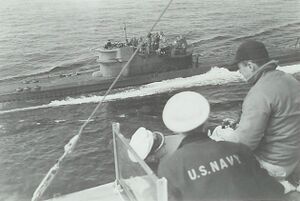Engineering:Type X submarine
 U-234 surrenders to missing name, 1945
| |
| Class overview | |
|---|---|
| Builders: | Germaniawerft, Kiel |
| Operators: | |
| Preceded by: | Type IX submarine |
| Succeeded by: |
|
| Built: | 1939 -1944 |
| In commission: | 1941 -1945 |
| Completed: | 8 |
| Lost: | 6 |
| General characteristics [1] | |
| Class and type: | Submarine minelayer |
| Displacement: | |
| Length: |
|
| Beam: |
|
| Height: | 10.20 m (33 ft 6 in) |
| Draught: | 4.71 m (15 ft 5 in) |
| Propulsion: |
|
| Speed: |
|
| Range: |
|
| Test depth: | Calculated crush depth: 220 m (720 ft) |
| Complement: | 5 officers, 47 enlisted |
| Armament: |
|
Type X (XB) U-boats were a special type of German submarine (U-boat). Although intended as long-range mine-layers, they were later used as long-range merchant submarines, a task they shared with the Type IXD and Italian Romolo-class submarines.
History
The Type X was originally designed specifically to accommodate the newly developed Schachtmine A (SMA) moored mine.[3] The initial design provided dry storage for the mines, which needed their detonators to be individually adjusted before launch; this submarine was projected to have displaced up to 2,500 tonnes.[4] A further variant, the Type XA was projected, which would have supplemented the main mine chamber with extra mine shafts in the saddle tanks. Neither type entered production.[5]
A total of eight Type XB boats were produced, which replaced the mine chamber of the projected Type XA with six vertical wet storage shafts in the forward section of the hull.[6] Up to 18 mines could be carried in these shafts, with an additional 48 mines in a series of 12 shafts set into the saddle tanks on each side. They only had two torpedo tubes, both at the stern.[1] When used as cargo-carrying submarines they carried freight containers in the mine shafts (or had the freight containers welded on top of the lateral shafts, preventing their use for mines).
The first Type XB was launched in May 1941.[1] At 2,710 tonnes submerged and fully loaded, they were the largest German U-boats ever built, and they had to sacrifice diving speed and agility.
Service history
Six of the eight boats built were sunk during the war (four with all hands) but two survived World War II. One survivor was missing name, which surrendered to US Navy ships on 14 May 1945 while en route for Japan with a cargo that included 560 kg uranium oxide, two Me 262 jet fighters, and 10 jet engines.
The other type XB to survive was missing name which reached Batavia (present-day Jakarta) in December 1944 with a cargo including dismantled V-2 rockets for Japan. Following Germany's surrender, U-219 was seized by the Japanese at Batavia on 8 May 1945 and on 15 July 1945 was placed into service with the Imperial Japanese Navy as I-505.
List of Type X submarines
There were eight Type X submarines commissioned.
- missing name
- missing name
- missing name
- missing name
- missing name
- missing name
- missing name
- missing name
Losses
Six Type XBs were lost to various causes.
- missing name was last heard of on 6 October 1942 in the North Atlantic and was presumed sunk.
- missing name was sunk on 7 August 1943 in the North Atlantic by aircraft from missing name.[1]
- missing name was sunk on 12 June 1943 near the Canary Islands by aircraft from missing name.[1] Sixteen crew survived.
- missing name was sunk on 24 June 1943 in the Bay of Biscay by ramming and depth charges from Script error: The function "ship_prefix_templates" does not exist..[1]
- missing name was sunk on 28 October 1943 in the North Atlantic by aircraft from missing name.[1]
- missing name was sunk on 5 July 1944 southeast of Halifax, Nova Scotia by destroyer escorts missing name and missing name.[1] There were 29 survivors.
References
Bibliography
- Gröner, Erich; Jung, Dieter; Maass, Martin (1991). German Warships 1815–1945, U-boats and Mine Warfare Vessels. 2. London: Conway Maritime Press. ISBN 0-85177-593-4.
- Rössler, Eberhard (2001). The U-boat: The evolution and technical history of German submarines. London: Cassell & Co. ISBN 0-304-36120-8.
- Williamson, Gordon (2005). Wolf Pack: The Story of the U-boat in World War II. Oxford: Osprey Publishing. ISBN 1-84176-872-3.
- Williamson, Gordon; Palmer, Ian (2002). Kriegsmarine U-boats 1939-45: Vol 2. Osprey Publishing. ISBN 1-84176-364-0.
Further reading
- Sharpe, Peter (1998). U-Boat Fact File: Detailed Service Histories of the Submarines Operated by the Kriegsmarine 1935-1945. Leicester: Midland Publishing. ISBN 1-85780-072-9.
External links
- Helgason, Guðmundur. "U-boat types: XB". http://uboat.net/types/xb.htm.
Template:German Type X submarines
 |
